Introduction
Access to clean drinking water is essential for health, yet many households face challenges related to water purity. Water filtration systems can significantly improve the quality of drinking water by removing contaminants, improving taste, and ensuring safety. This article explores the different types of home water filtration systems, their health benefits, and potential downsides to help you make an informed decision.
Types of Home Water Filtration Systems
- Activated Carbon Filters: These are the most common type of filter found in household water pitchers, faucet attachments, and under-sink systems. They remove chlorine, sediment, volatile organic compounds (VOCs), and taste and odor issues from water.
- Benefits: Cost-effective and reduces a wide range of contaminants.
- Downsides: Does not remove minerals, heavy metals, or microorganisms.
- Reverse Osmosis (RO) Systems: These systems use a semipermeable membrane to remove contaminants down to 0.0001 microns, including fluoride, salt, sediment, and some bacteria.
- Benefits: Provides very high-quality water and can remove a broader range of contaminants than carbon filters.
- Downsides: Wastes a significant amount of water, is more expensive, and requires more maintenance.
- Distillation Units: These units boil water and then condense the steam back into liquid, removing contaminants.
- Benefits: Highly effective at removing bacteria, viruses, heavy metals, and minerals.
- Downsides: Slow process, energy-intensive, and can leave water tasting flat because it removes oxygen.
- Ultraviolet (UV) Filters: UV filtration uses ultraviolet light to kill bacteria and viruses without adding chemicals.
- Benefits: Effective at disinfection and does not alter the taste of water.
- Downsides: Does not remove non-biological contaminants like heavy metals and VOCs.
- Ion Exchange Filters: These are designed to soften water by replacing undesirable ions with others that are less problematic.
- Benefits: Effective at reducing limescale, softening water, and removing radium and barium.
- Downsides: Does not remove most other contaminants and can increase sodium levels in the water.
Health Benefits of Water Filtration
- Improved Water Quality: Filtration removes potentially harmful contaminants that can affect health, including lead, pesticides, and bacteria, ensuring safer drinking water.
- Enhanced Taste and Odor: Filters can remove elements that cause poor taste and odor, making drinking water more palatable and encouraging hydration.
- Reduced Risk of Disease: By removing pathogenic bacteria and viruses, water filters can reduce the risk of gastrointestinal diseases and other health issues related to contaminants.
Potential Downsides
- Maintenance Requirements: Some filtration systems require regular maintenance, including filter changes and cleaning, which can be costly and time-consuming.
- Initial Setup Cost: High-efficiency systems like RO and UV can be expensive to install.
- Environmental Impact: Systems like RO generate wastewater, which may be a consideration for environmentally conscious consumers.
Conclusion
Choosing the right water filtration system depends on your specific water quality needs, budget, and the contaminants you need to remove. It’s important to test your water to understand which contaminants are present, as this will guide your decision on which filtration system is most effective for your home. While the benefits of filtered water are clear in terms of health and taste, each system comes with its own set of considerations. Investing in a water filtration system not only ensures safer and tastier drinking water but also contributes to the overall well-being of your household.

